Make easy, artisanal, bakery-style, No Knead Focaccia — with minimal effort! Soft and fluffy bread with a crisp golden crust. Making this Italian bread at home is easier than you think! A homemade bread recipe that’s delicious and easy. For the best flavor sprinkle liberally with Everything Bagel seasoning and lots of fresh herbs.
What is No Knead Focaccia?
No Knead Focaccia is a simple bread recipe that does not require kneading. Typically, kneading is needed to develop the gluten network in the dough and give it structure and flavor. However, the no knead method lets the dough slowly ferment in the fridge for 24-72 hours. Instead of kneading, the dough develops flavor and gluten in a slow, long rise in the fridge.
The no-knead method works especially well with focaccia. The dough sits in the cold fridge for a long fermentation time, allowing the focaccia to develop its characteristic light and airy crumb. There is no need for a first rise or second rise. Instead, let time (24-72 hours) do the work for you! With minimal effort, you can get a gorgeous golden brown focaccia with crispy corners and airy bubbles.
To add even more flavor, add Everything Bagel seasoning and fresh herbs on top. The combination is irresistible. Good for sandwiches. Or with soup, pasta, and other dinnertime favorites.
Bake in a sheet pan until that golden crust forms on the bottom. This makes a large portion for leftovers the next day. Enjoy!
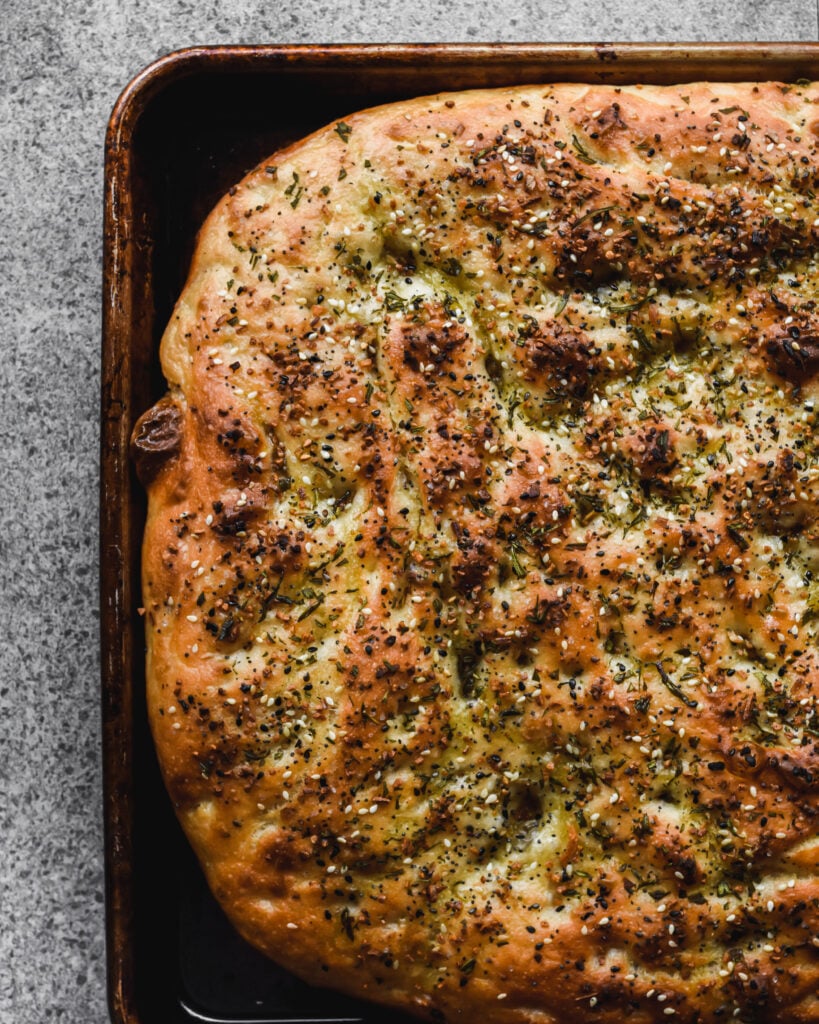
How does the No Knead Method work?
Typically, kneading is required to develop the gluten network in dough necessary for good bread. But for this focaccia recipe, a combination of factors work together to achieve that open-holed, airy crumb, chewy texture, and deep flavor without kneading:
- High Hydration Dough. Simply put, this is a very wet dough. The more hydrated the dough, the more elastic — resulting in an open, airy crumb!
- Fold + Stretch Technique. Typically used for wetter doughs, this technique gently develops gluten over time. Kneading forces gluten strands to develop quickly. By contrast, folding and stretching create air bubbles over time. A higher rise than regular kneading alone.
- Long, Slow Rise. A longer, slower rise gives more time for fermentation to do its work. More fermentation = more time for flavor to develop. I recommend at least 24 hours in the fridge for best flavor.
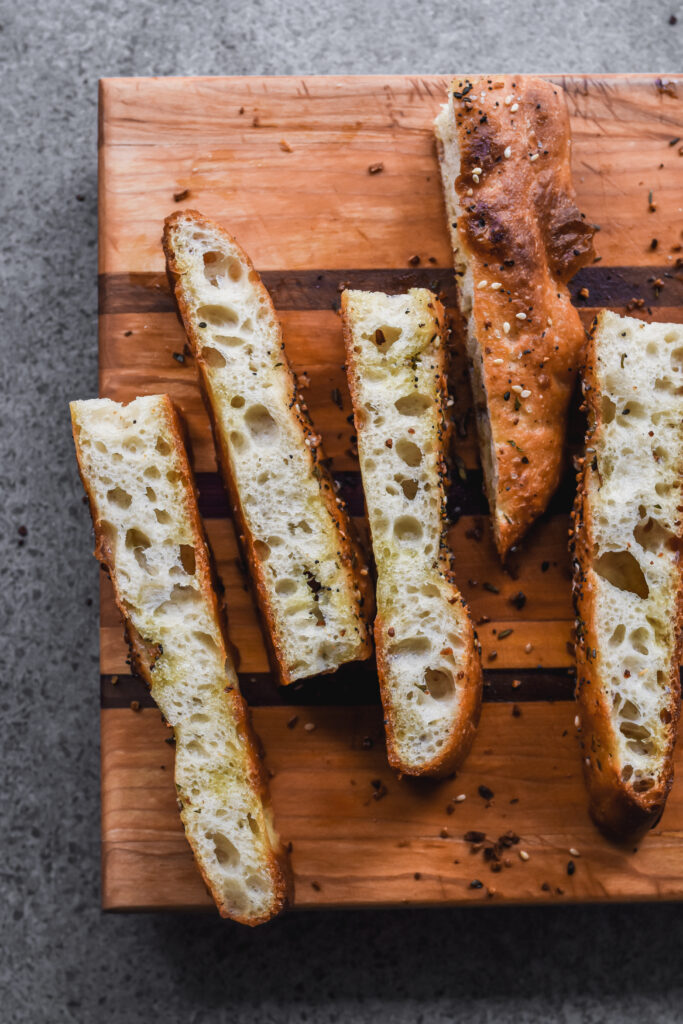
Ingredients:
- Bread Flour. Bread flour contains a higher protein percentage than regular all-purpose flour. Basically, more protein = more gluten development, which helps with structure. The end result is a higher rise and chewier, lighter crumb.
- Extra Virgin Olive Oil. Use good olive oil — it really makes a difference. Although the amount reaches near obscene levels, you do need all of it. A hallmark of good focaccia is that deliciously oily flavor. Also, the oil prevents the dough from sticking to the pan.
- Instant Yeast. Easier to use than active dry yeast, it requires no proofing or water activation. (Note: I proof mine just to make sure it still works. See the recipe notes below.)
- Sugar. A little bit helps speed the fermentation process along. Yeast loves sugar!
- Lukewarm water. Hot water can kill yeast. If using a thermometer, make sure the water is not above 110F.
- Everything Bagel Seasoning + Fresh Herbs. Focaccia typically includes toppings or seasoning. To make it extra flavorful, add Everything Bagel seasoning and fresh Rosemary. The modern combination is so delicious!
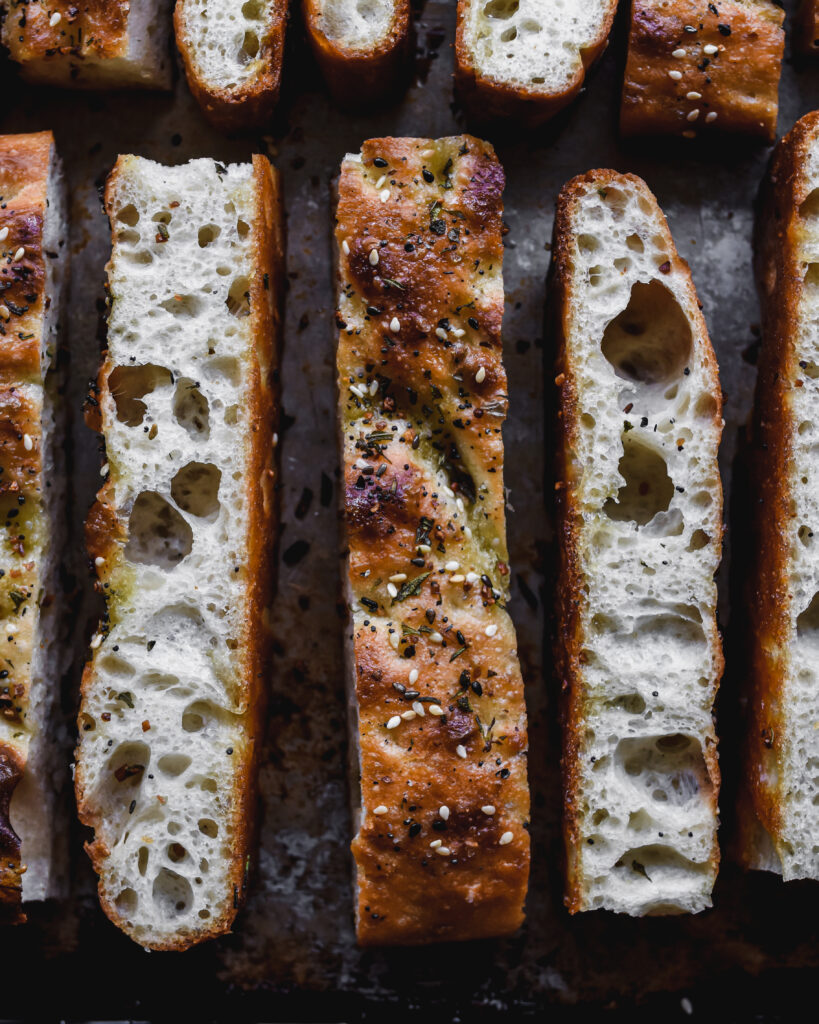
How to make Homemade Focaccia:
- Make the dough. In a large bowl, add all the dry ingredients. Whisk the ingredients together. Make a hole in the center and add the wet ingredients. Using a rubber spatula or wooden spoon, mix until a shaggy dough forms and there are no dry streaks.
- Fold + stretch the dough. Every quarter turn, grab the end of the dough and fold it over. Fold and stretch the dough at least 4 times.
- Let the dough rise. Cover tightly and store in the fridge for 24-72 hours.
- Bake. Transfer the dough onto a well-oiled sheet pan. Gently stretch the cold dough to the corners of the sheet pan. Dimple the surface of the dough with your fingers. Sprinkle with Everything Bagel seasoning + fresh rosemary and flaky salt. Drizzle with more olive oil. Bake focaccia at 450F/230C for 22-24 minutes, until golden brown and a crisp crust on the bottom (check with a spatula to make sure).






Watch how to make it:
PRO Tips:
- Handle Gently. For great focaccia, keep the airy bubbles intact. Handle the dough as little as possible. Do not crush or smother the airy pockets.
- Preheat Oven. For better oven spring, make sure to preheat the oven at least 30 minutes. A hot, well pre-heated oven will yield the best rise.
- Rest after baking. Do not cut into the focaccia immediately! Instead, let it rest for 15-20 minutes. The olive oil that has pooled at the bottom of the sheet pan will reabsorb into the bread, making it delicious and moist.
- Use a large spatula. To remove the focaccia, slide a large fish spatula under the bread to loosen the bottom first. That way, you won’t lose any of those gloriously golden bits on the bottom.
Variations:
There are countless variations for homemade no-knead focaccia. Add your favorite toppings. Some ideas:
- Tomatoes. Halve cherry tomatoes and place face down into the dimples. Or, slice beefsteak tomatoes and shingle over the top.
- Olives. Chop a mix of black Kalamata and green Spanish olives and liberally sprinkle all over.
- Fresh herbs. Finely mince a combination of fresh oregano, parsley, thyme, and rosemary. Make sure to drizzle with olive oil and flaky sea salt before baking so the fresh herbs do not burn!
- Figs. Thinly sliced figs caramelize and turn even sweeter when baked!
- Pesto. Smear pesto all over the dimpled dough.
- Red onion. Thinly sliced red onion scattered all over lends a Bialy-style vibe.

FAQ
Everything Bagel Seasoning in available in most grocery stores. I found mine at Costco. Other stores that sell it: President’s Choice, Trader Joe’s, Albertson’s, Safeway — to name a few. If you can’t find it, make your own at home with this recipe.
Note: some versions of Everything Bagel seasoning do not include salt. (You will have to add more salt, if that’s the case.)
Yes, you can easily halve the amount and bake, as per usual, in a 9×13″ pan.
My recipe makes a HUGE amount. A giant 13 x 18″ sheet pan of focaccia goodness! Even for my family of 5, the sheet pan portion is quite large. But honestly? I love to bake the full sheet pan and freeze leftovers for another day.
Like most bread, Focaccia tastes best the day it’s made. Fortunately, the olive oil keeps Focaccia moist and delicious even on the 2nd day. But anything longer than 2 days and the bread will become too stale and hard to eat. I recommend freezing after that.
Yes, homemade focaccia freezes BEAUTIFULLY. After the bread is fully baked and cooled, slice into individual portions. Stash in a large ziploc baggie in the freezer, where it should last 3-6 months.
To reheat, warm in a 350F oven for 5-10 minutes. The texture will be the same as the day you baked it!
FYI, for freezer storage: I cut focaccia into long strips (to eat with soups + pasta) and squares (for sandwiches). That way, it’s easy to pull out individual portions from the freezer and enjoy freshly baked homemade focaccia anytime you like.
Although no knead focaccia tastes best with a long, slow rise — yes, you can bake without it. It’s still delicious and I often do this when I’m in a time crunch.
After folding the dough, spread out onto an oiled sheet pan. Cover with plastic wrap and let is rise in a warm, draft-free location until doubled in size (about 1-2 hours). Bake, as per usual.
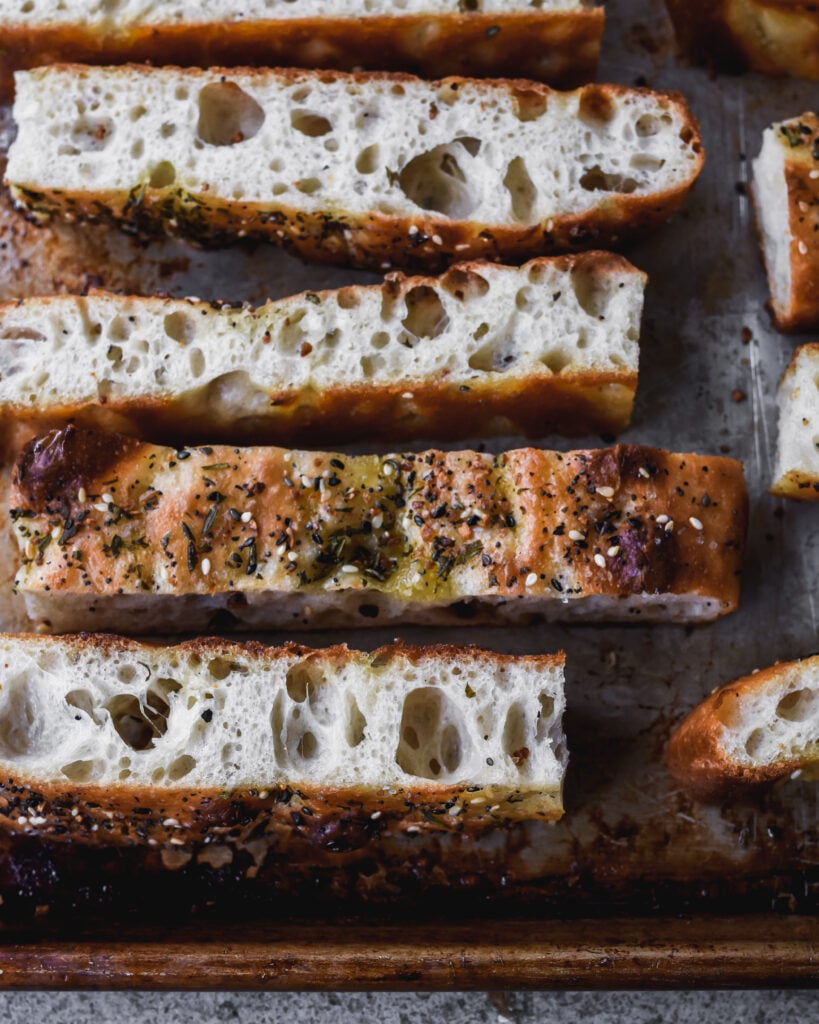
More bread recipes:
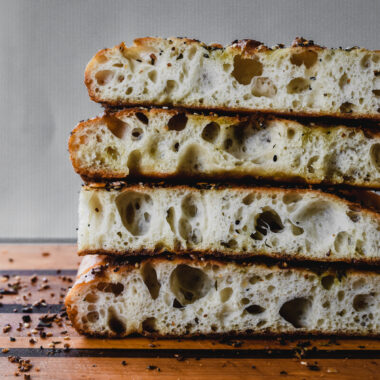
No Knead Focaccia Recipe with Everything Bagel Seasoning
Equipment
- Large Bowl
- 13 x 18" sheet pan
- stiff spatula
Ingredients
Dough:
- 2 1/2 cups/575g warm water
- 2 1/4 tsp instant yeast (1 packet, 1/4 oz)
- 1 Tbsp sugar
- 5 cups/ 700grams bread flour
- 2 tsp salt
For baking:
- 1/2 cup extra virgin olive oil (for sheet pan)
- 3 Tbsp Everything Bagel seasoning
- 2 Tbsp fresh rosemary, chopped (about 2 sprigs)
- 2-3 Tbsp extra virgin olive oil (for drizzling)
Instructions
Dough:
- In a large bowl, add warm water. Sprinkle yeast and sugar over the water. Wait a few minutes to make sure the yeast is active and still alive. When it foams and slightly bubbles, that means the yeast is good.
- Add flour and salt. Using a stiff spatula, mix until a shaggy dough forms. Make sure there are no dry patches.
- Stretch and fold the dough 4x: dip fingers into water (to prevent sticking) and gently grab one end of the dough ball. Lift the dough and fold to the opposite end. Repeat until all sides of the dough ball have been stretched and folded. Refer to the video, if needed. (The dough will be wet and shaggy. It's ok if it dough doesn't stretch and fold as easily as in the video).
- Cover dough tightly and rest in the fridge for 24-72 hours. I recommend at least 24 hours but it can stay in the fridge for up to 72 hours. The dough should be doubled in volume and bubbly.
Baking:
- Preheat oven to 450F/230C. Add extra virgin olive oil to the sheet pan. Spread the oil gently with a brush, making sure the bottom surface and sides are well coated with oil.
- Remove dough from the fridge. Transfer the cold dough to the sheet pan carefully and gently. Spread out the dough with your fingers. Handle the dough as little as possible, to keep the air bubbles intact. It's ok if the dough doesn't reach the corners completely. If the dough starts sticking to your fingers, dip fingers into the olive oil on the sheet pan.
- Dimple the dough with your fingers. Sprinkle with Everything Bagel seasoning + fresh rosemary. Drizzle with more olive oil.
- Bake until golden and crispy, about 22-25 minutes. Be careful, as the olive oil will be pooled around the bread. (Don't worry, it will absorb into the bread).
- Cool for 10-15 minutes, on top of the stove or counter. The cooling time will help the bread absorb all of that olive oil goodness. Use a large spatula to loosen from the sheet pan. Slice with a bread knife and enjoy!


